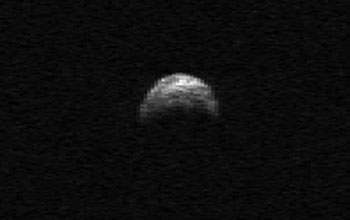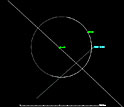Media Advisory 11-024
Near-Earth Flyby of Large Asteroid to Occur on November 8: Chat Live This Thursday Online With Astronomers
Ask scientists about a large asteroid that will pass between the Earth and moon in a close encounter between our planet and a near-Earth object

Asteroid 2005 YU55 observed by Arecibo Telescope--a National Science Foundation facility.
October 31, 2011
This material is available primarily for archival purposes. Telephone numbers or other contact information may be out of date; please see current contact information at media contacts.
You are invited to participate in a live online chat this Thursday from 3 p.m. to 4 p.m. EDT with two eminent astronomers from the National Science Foundation (NSF) and NASA, who will discuss a large asteroid that will approach close to Earth on Nov. 8, 2011 and the science of such near-Earth asteroids.
This rare flyby of the asteroid--which is known as 2005 YU55--will likely draw significant public interest because of the asteroid's large size of about 396 meters (1,300 feet) in diameter, the nature of its close encounter with Earth and the public's fascination with near-Earth objects.
The chat is sponsored by ScienceNOW, the daily news site of the journal Science. To participate, go to ScienceNow's website on November 3 at 3 p.m. EDT and submit questions to:
- Scott Fisher: A program director in the Division of Astronomical Sciences at the National Science Foundation and a staff scientist at the Gemini Observatory--a large international observatory with eight-meter telescopes located in Hawaii and Chile--where he researches planet formation.
- Donald K. Yeomans: A scientific investigator on NASA's Deep Impact mission that successfully impacted comet Tempel 1 in July 2005, and a senior research scientist at the Jet Propulsion Laboratory, where he contributes to predictions of future close Earth approaches and impacts by comets and asteroids.
The November 3 chat about asteroid 2005 YU55 and other near-Earth objects provides an ideal opportunity to ask experts about these and other topics:
- What is currently known about the 2005 YU55's size, shape, orbit and origins?
- What are the real dangers potentially posed by asteroids and comets vs. threats hyped by doomsayers?
- What is the likelihood that 2005 YU55 will ever crash into the Earth?
- When and where is the best place to view 2005 YU55?
- How are scientists currently tracking comets and asteroids that may impact the Earth?
- What types of additional information are scientists likely to learn about 2005 YU55 and asteroids in general via radar, visual and infrared monitoring of the asteroid during its close approach to Earth?
The live online chat on 2055 YU55 is part of the journal Science's weekly series of chats on the hottest topics in science held every Thursday at 3 p.m. EDT.
-NSF-
-
From November 8 to 9, asteroid 2005 YU55 will travel closer to the Earth than the moon ever does.
Credit and Larger Version
Media Contacts
Daniel Strain, Science Magazine, (202) 326-7089, email: dstrain@aaas.org
Lily Whiteman, National Science Foundation, (703) 292-8310, email: lwhitema@nsf.gov
Related Websites
Current and past ScienceLIVE chats on: http://news.sciencemag.org/sciencelive/
Web site of chat on asteroid flyby and other near-Earth objects: http://news.sciencemag.org/sciencenow/2011/10/live-chat-the-asteroids-are-comi.html
The U.S. National Science Foundation propels the nation forward by advancing fundamental research in all fields of science and engineering. NSF supports research and people by providing facilities, instruments and funding to support their ingenuity and sustain the U.S. as a global leader in research and innovation. With a fiscal year 2023 budget of $9.5 billion, NSF funds reach all 50 states through grants to nearly 2,000 colleges, universities and institutions. Each year, NSF receives more than 40,000 competitive proposals and makes about 11,000 new awards. Those awards include support for cooperative research with industry, Arctic and Antarctic research and operations, and U.S. participation in international scientific efforts.
Connect with us online
NSF website: nsf.gov
NSF News: nsf.gov/news
For News Media: nsf.gov/news/newsroom
Statistics: nsf.gov/statistics/
Awards database: nsf.gov/awardsearch/
Follow us on social
Twitter: twitter.com/NSF
Facebook: facebook.com/US.NSF
Instagram: instagram.com/nsfgov



